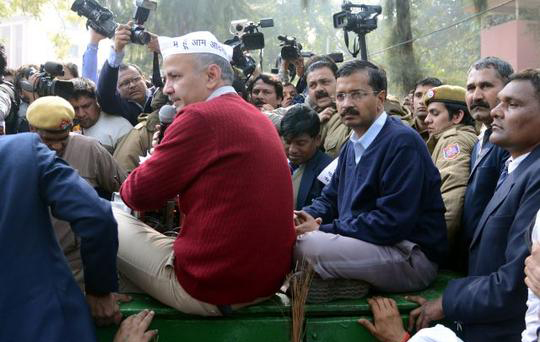
New Delhi, Jan 21: Delhi Chief Minister Arvind Kejriwal Tuesday said his protest was indefinite and threatened to fill the street with lakhs of people, if the government does not concede his demands.
"I said 10 days, but it was a way of saying that the protest is indefinite. If the central government does not agree to our demands by Jan 26, then we will fill Rajpath (the central boulevard in the heart of central Delhi) with lakhs of people," said the chief minister.
The rain also didn't deter the chief minister and he remained adamant on sitting outside the Rail Bhavan, as his sit-in for pressing the demand for control over Delhi Police and suspension of five policemen continued for the second day Tuesday.
"We will continue to sit here and this will be the best Republic Day. People will come from different parts of the country and this Republic Day there won't be processions but government will find people on the streets," he said.
Earlier in the day, Kejriwal criticised the union home minister, saying Sushilkumar Shinde does not have the right to decide where he should sit for protest.
"Who is Shinde to tell me where to protest and where not to? I am the chief minister of Delhi and I have the right to decide not Shinde, instead I can decide where Shinde can stay," Kejriwal told reporters outside the Rail Bhavan here.
The chief minister, along with his ministers and volunteers, spent the entire night on the road outside the Rail Bhavan raising slogans.
Due to the ongoing protest, four Delhi Metro stations in the heart of the capital, which were closed Monday, continued to remain shut Tuesday.
"I realise that the closing of the Metro stations has caused a lot of trouble for the common man. So, I am telling Shinde to open them and stop causing inconvenience to the people," Kejriwal said.
He said the area has been surrounded with barricades, turning it into a jail. The chief minister also complained about the absence of toilet facility in the area.
"Today in the morning, I myself broke the barricade and my ministers went to the toilets. Shinde has closed the toilets of all the buildings. We are people from India not Pakistan."
"Why is the home minister treating us like this? Where will the women go to use the toilets?", Kejriwal asked.





Comments
Add new comment